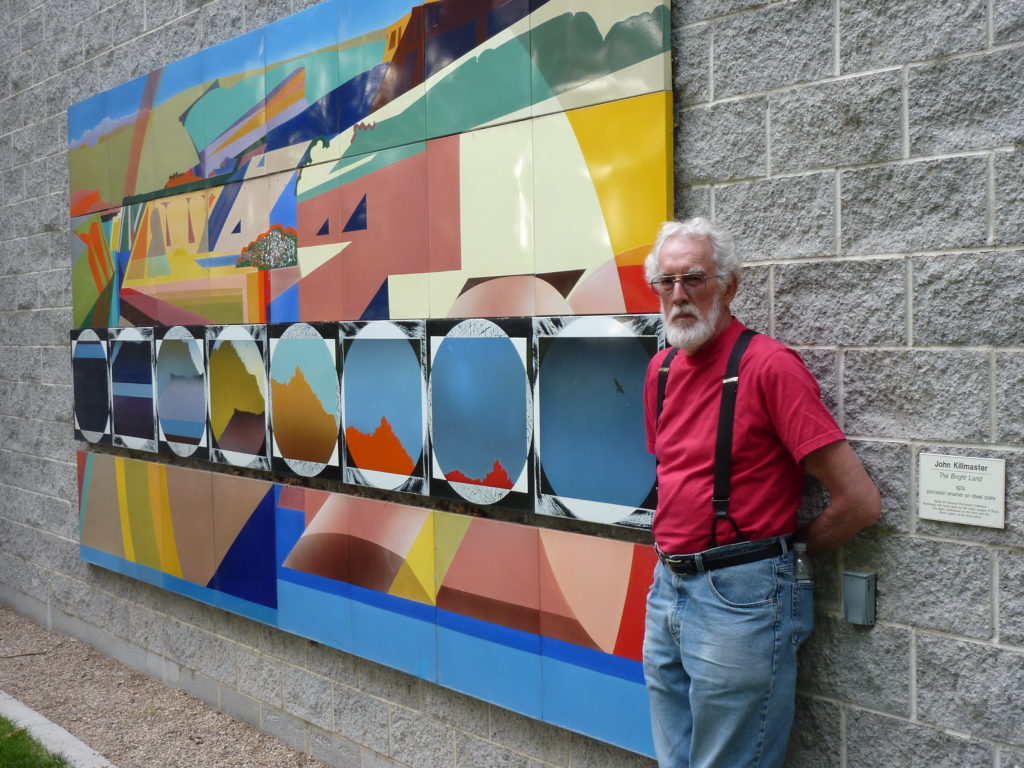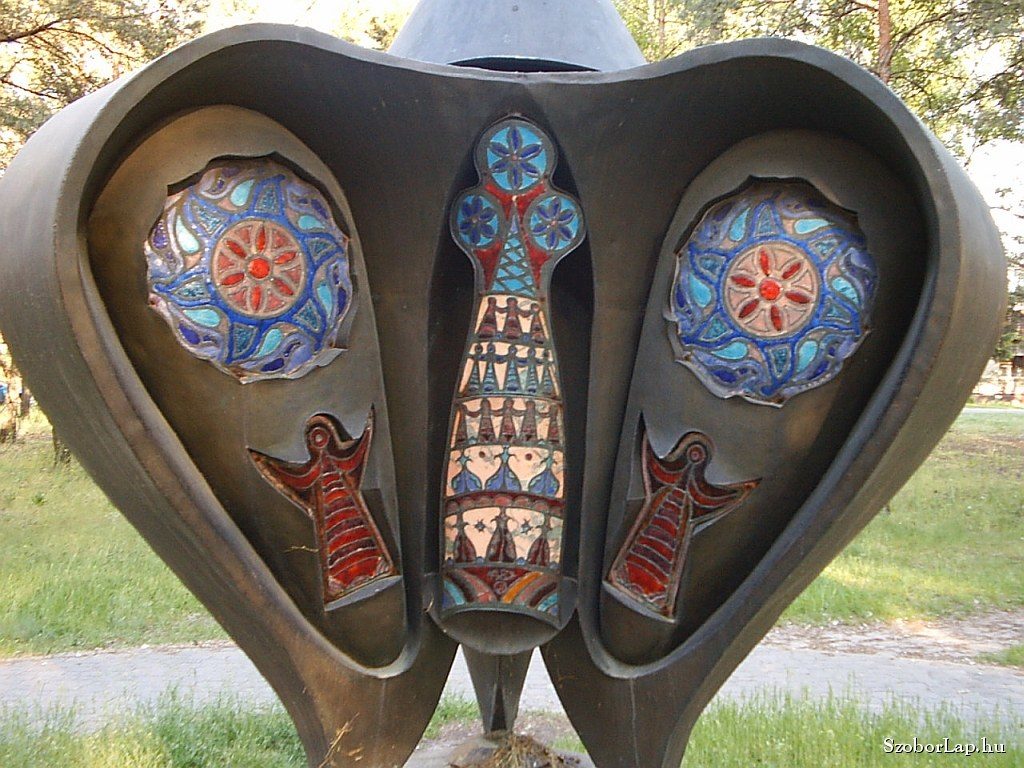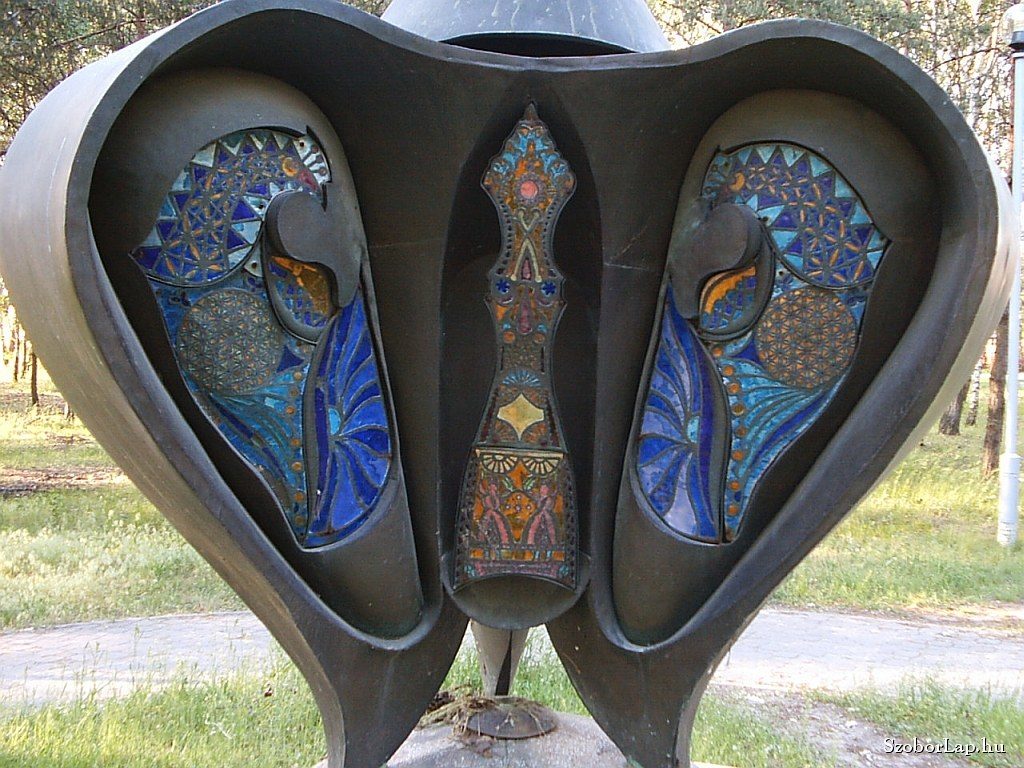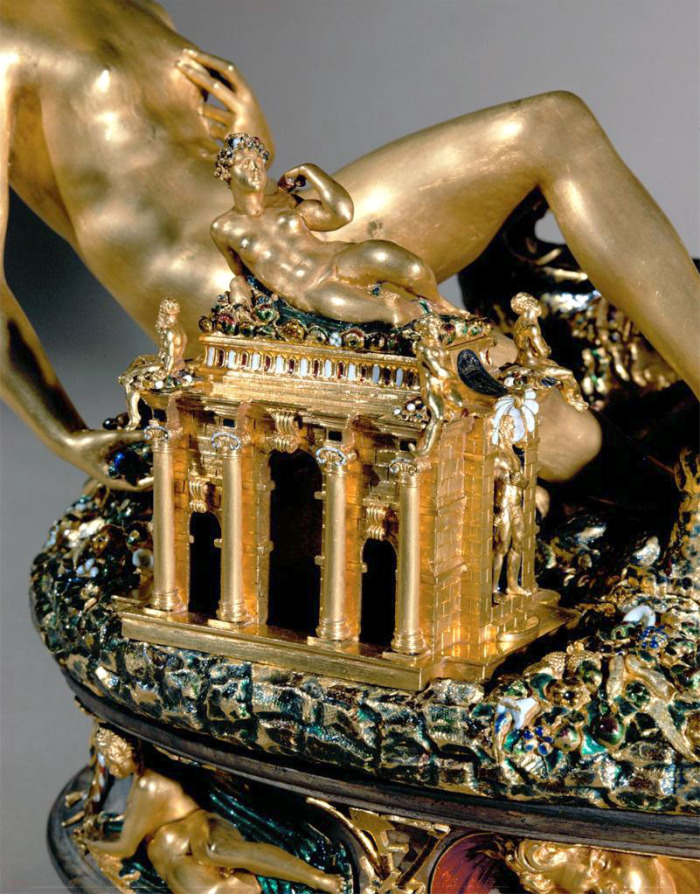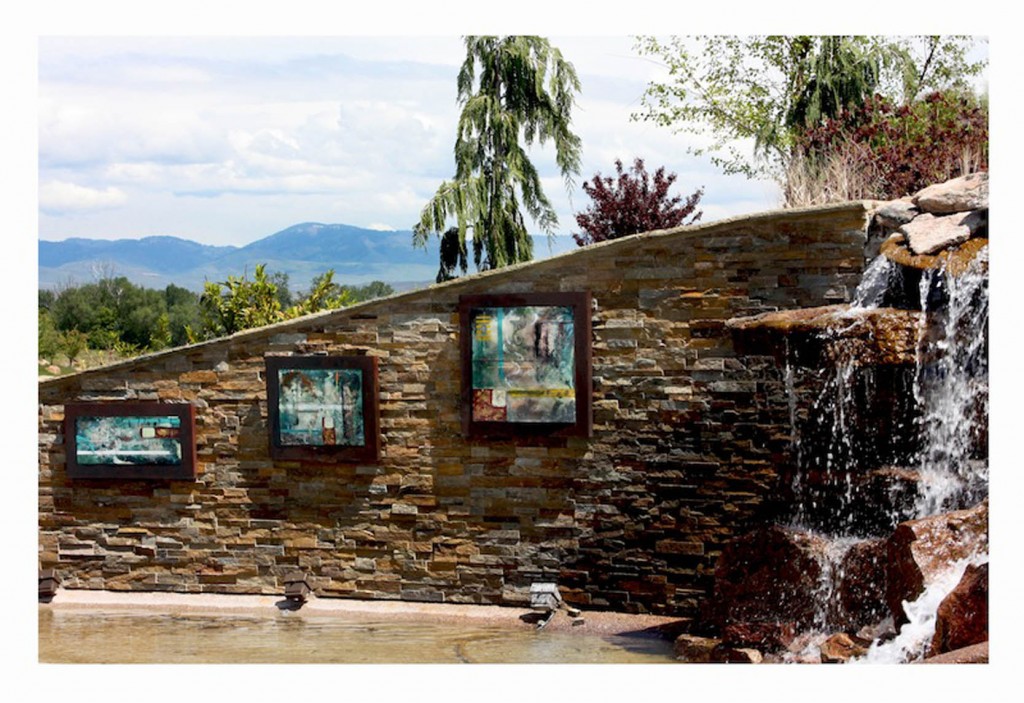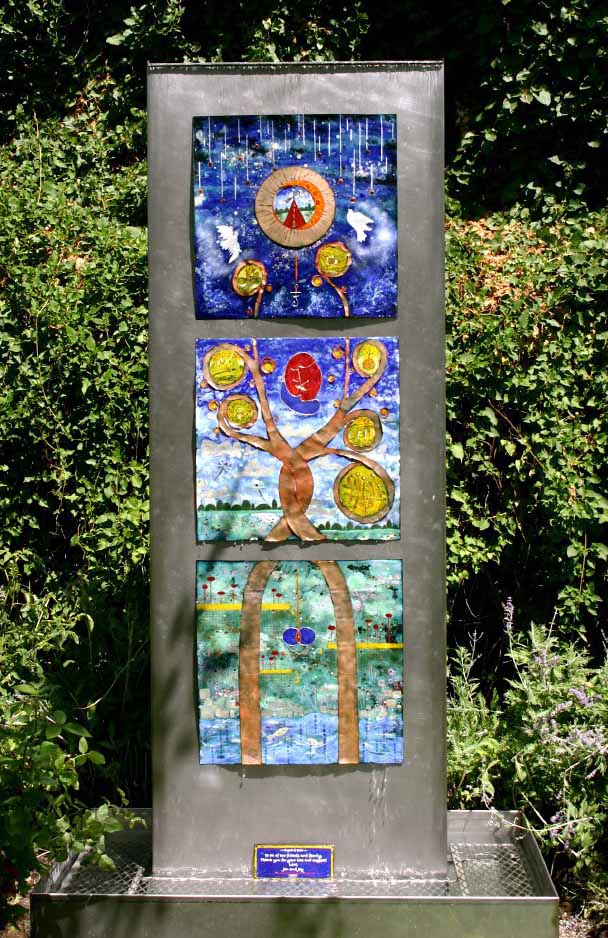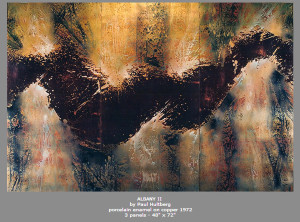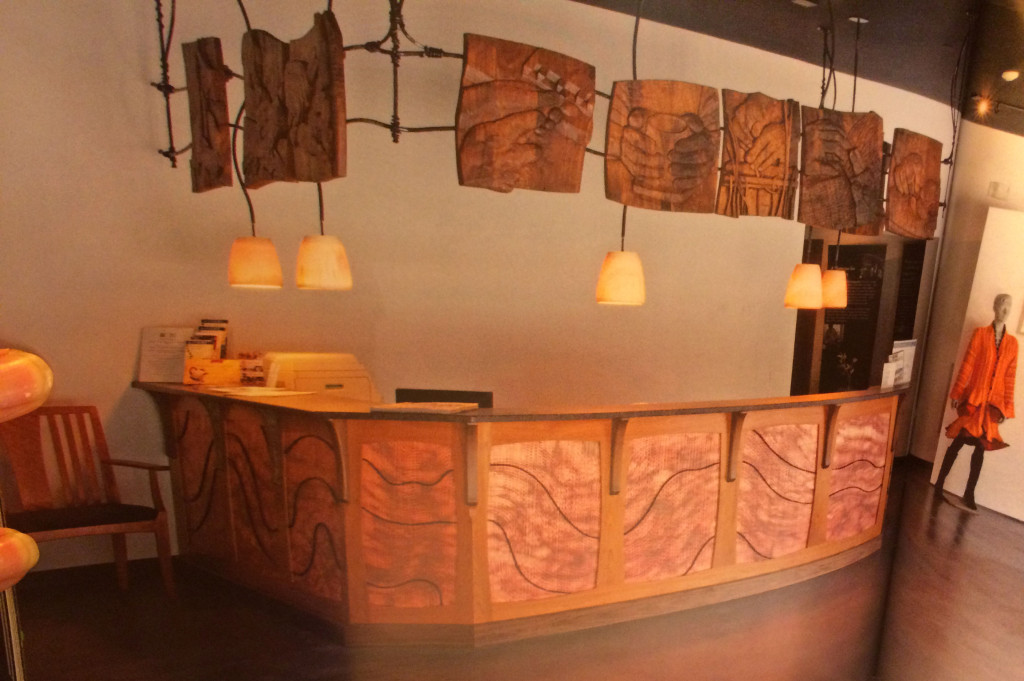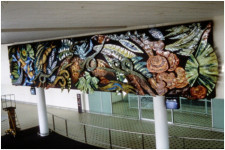Each season, AFFAE, Inc. will feature images from a contemporary artist whose work includes the medium of vitreous enamel to create expressive wall hangings and/or sculpture. Artists who limit their creations to vitreous enamel are few, but some enamel crafters venture into expressive art, and some artists working primarily in other media at times fall captive to the charms of enamel, despite the challenge of the kiln. We appreciate that images never can capture the qualities of fired work completely, but we will do our best.
Paul Hultberg
Hultberg has been called the “Jackson Pollock” of enameling. While he certainly does enamel work in a conventional manner, he also has used a technique which results in abstract expressionist images. He spreads enamel powder on a thin sheet of cooper along with water and adhesive. He mixes these up and spreads them around. He then fires this outside of a kiln. He uses a gas torch which he also moves around. The result of this process is an enamel of splotches of color, fire scale copper discolored by the flames, and other coloration that are the result of oxidation and Hultberg’s selective scraping and chipping. Sometimes His enamels are heated by torches under the copper.
Thus, Hultberg creates non-conventional abstract expressionist works of art with enamel.
Hultberg was born in California and studied and taught all over the United States and Mexico, from Mexico City to Brooklyn. He has done murals and has been shown in many prestigious exhibitions.
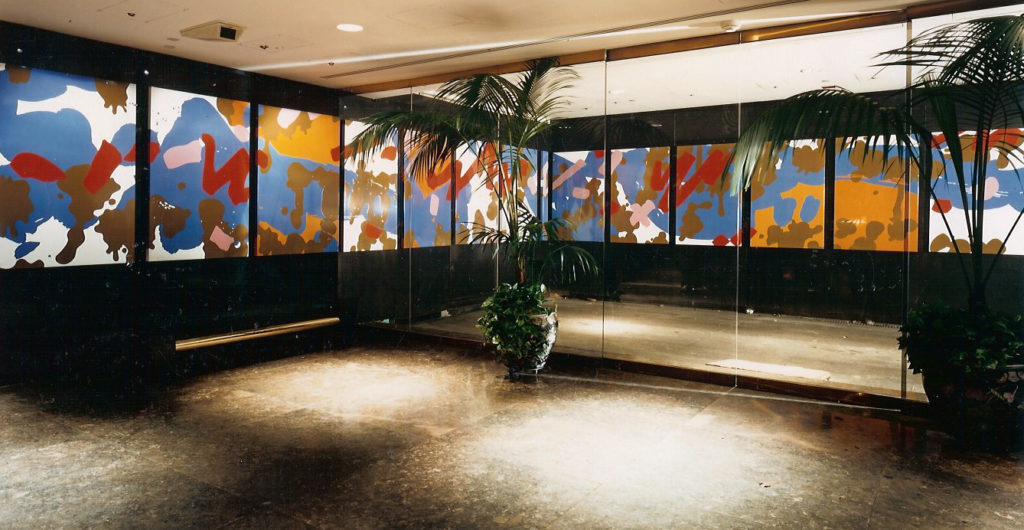
APPLE DAPPLE 1986, Porcelain enamel on steel 5 ft x 60 ft. 16 panel commissioned installation for Metro Media in NYC.

Busch Gardens Escalator, Tampa FL. 1958, Porcelain enamel on steel, Commissioned work for Anheuser- Busch
John Killmaster
John Killmaster is very much a part of contemporary American enamel world. He uses enamels in variety of ways, and he has invented new techniques of applying the medium to metal.
John can mix enamel powder with acrylic medium and paint enamel on. He also has developed his own enamel crayons.
Also, he has applied the enamel with his crayon sticks. I remember an instructional article by John showing how to make your own kiln thus I suspect he fires his enamels in kiln that he built himself.
This is the picture of John Killmaster with the large enamel which he did in 1974. The work is composed of steel covered with porcelain enamel.
“Storming Gods” 22″ h x 22″ w x 3″ d. (inches). Porcelain enamel fired on repousse’ steel (granular spray sgraffito grisaille technique), 1989
“Tribute to Harry Morrison, Builder of the dams in the West” . porcelain enamel fired on repousse’ steel, 9’h x 12’w ( feet) x 6 inches deep. 1983. Installed in Boise State University’s Morrison Center of the Performing Arts, Boise ID.
Wildflowers. Porcelain enamel on steel 16 x 20
“Blues Man” 8×10 inches, 1991. Brush able enamel fired on steel.
As Birds, Men Are Snared In An Evil Age” porcelain enamel fired on repousse’ steel -sgraffito grisaille. 4×6 feet
“Stars, moon and galaxies”. Enamel crayons and watercolors on a washing machine lid. Porcelain enamel on steel.
“Soul Singer” oil alla prima enamel technique
“Wall multi sectioned enamel” Somewhat Southwest” hammered steel porcelain enameling 7 x 9 feet.
JESSICA CALDERWOOD
Jessica Calderwood is very active now in the United States. She is a professor at Ball State University in Indiana. She uses a mixed media approach, with enamel, different metals, all sorts of industrial processing, and a wild imagination. We will focus on her works which are mainly enamels.
The Enamels above convey a quality of human emotions. The nature of the emotions is not explicitly depicted. Thus there is an atmosphere of mystery about these enamels.
Here are two female figures hiding their faces, do they feel shame? Embarrassment? Are they duplicitous? What is happening in their lives?
One is supporting the other. They are looking out at the world. Are they amused or frightened by what they see?
Ref-
https://toryfolliard.com/artists/jessica-calderwood/
http://www.jessicacalderwood.com/
SZVETLANA TOTH (Hungary)
Szvetlana Toth is from Russia, but she has lived and worked in Hungary since 1991. She has studied art and has worked as a painter and an art restorer. She now enamels. Her location gives her access to a wide variety of brands of enamels.
For the Body, Mind and Spirit

This piece was done with decals which Ms.Toth painted herself. The piece is 40X50Cm (15.5X19.5 inches).
Cats
Worship
The work consists of three plates. The process work is conducted simultaneously on three plates.
Flower
Lily
KANA LOMROR (India)
Kana Lomror was born in 1977 and grew up in the Sikar district of Rajasthan, India., This is an area famous for the vibrant colors of clothing and houses.
He went to the University Rajasthan of Fine Arts in Jaipur in 1994 and he continued on to a master’s degree in fine arts from Visva Bharati University in West Bengal, one of the most famous centers in India. He was first interested in traditional murals but his attention shifted to enamel art. The endless possibilities for experimentation with enamels is a strong motivator for him. As with so many of us, he hopes to see vitreous enameling fully accepted as an art medium.
Title – Mystery in the City III
Medium – Vitreous enamel on steel
Size – 20″ x 18″
Title – Dancers I
Medium – Vitreous Enamel on Copper
Size – 29″ x 25″
Title – Fighting for Freedom II
Medium – Vitreous enamel on steel
Size – 30″ x 18″
Title : Nirvan 8
Medium : Vitreous Enamel on Copper, Copper wire, Acrylic on canvas
Size : 16″ x 30″ (original)
ENAMEL DOORS
Doors may be one of the most common objects in our lives. How many doors do people open and close during the day? Few doors are decorated so that there is anything noticeable about them. Doors decorated by, or fashioned from, vitreous enamel are rare period. Three such doors are described below.
Kay Whitcomb
|
Kay Whitcomb did the 7 feet high double door. these two pieces were originally free-standing art but were later refashioned with added handles and hinges. They were probably never actually used as functional doors.
A pair of Kay Whitcomb enamelled doors
Circa 1970
Enamel on steel, fired in Belgium.
Height of each 7ft (2.13m); width 32¼in (82cm)
Napoleon Jones-Henderson
Napoleon Jones-Henderson was born in 1943 in Chicago, Illinois.
Over the years, He is been particularly involved with African American art.
In recognition of his art, Jones-Henderson received the Merit of Honor Award from the Walters Art Museum and the Award for Outstanding Recognition from the Museum of Science and Industry. He was also honored by the National Conference of Artists with the Award of Excellence.
Jones-Henderson created a set of double doors which are indeed functional. They are at the entrance to a collage library.
Nyame Birbi Wo Soro
Roxbury Community College (Entry doors of Library), 1987, Enamel on Copper on Mahogany, 10’x10’x3″
Enamel doors can be quite heavy and might not easily be installed in domestic house. However, the door might be decorated with enamel panels. The front door of Howard Eisman house has three such decorative enamel panels.
A very common exterior door has had three enamels fitted into the doors paneling. This is a good background for enamels. It has the advantage of not requiring any additional carpentry.
Howard Eisman’s Bio can be found in other locations in this website and on his own website, www.archenamels.com
Enameled door panel by Indian artist Kana Lomror.
Title : Icons Series
Medium : Vitreous Enamels on Copper & Steel
Size : 12″ x 12″ each panel (6 panels 3 panels on Copper and 3 panels on Steel)
NEW DEVELOPMENT
FALL 2018
TURI ENDRE Painter, Enamelist, BUDAPEST, Born 1935
He is a European enamelist who has been using enamels for fine arts. He has been active in enameling close to 30 years. He has done enamels for both indoor and outdoor exhibitions and his enamels have been exhibited at public places.
Turi Endre graduated from the Hungarian Academy of Fine Arts in 1959. He moved to Kecskemét and he worked in Lampart’s Zománcipari Művek factory, This job acquainted him with the process of enameling. By the 1980s, he had developed his own unique style of using glass on metal.
He has used Hungarian folk art as a frequent theme for his art.
 In 1984 he became the Director of the International Fine Arts Exhibition in Kecskemét. He was elected Vice President of the Hungarian Society of Fire Enthusiasts. From 1989 onwards, he taught at the College of Fine Arts in Bratislava for two years. He is an organizer and regular participant of the Kecskemét Fine Arts Exhibition.
In 1984 he became the Director of the International Fine Arts Exhibition in Kecskemét. He was elected Vice President of the Hungarian Society of Fire Enthusiasts. From 1989 onwards, he taught at the College of Fine Arts in Bratislava for two years. He is an organizer and regular participant of the Kecskemét Fine Arts Exhibition.
Reference …
http://www.kieselbach.hu/muvesz/turi-endre_6993
https://www.kozterkep.hu/~/9300/Kun_emlekmu_Jakabszallas_1988.html
Winter 2016-2017
Our enamellist for the winter season is Virgil Cantini
Virgil Cantini was born in Italy in 1919 and came to the United States with his family as a child. After serving in the Army in the Second World War he obtained a Master of Fine Arts from the University of Pittsburgh in 1946. Two years later his enamel, “Masquerade” brought him national attention when it was included in the 13th National Ceramic Exhibition in Syracuse, New York. He would become one of the most well-known enamellists of the 20th century, with numerous public and private commissions.
Raised Catholic, Cantini was drawn to religious subjects, and many of his early works have liturgical themes. Durable and colorful, vitreous enamel was an ideal medium for large work in public places and examples of Cantini’s work, enamel and sculpture, can be seen around the city of Pittsburgh.
Cantini was instrumental in creating and directing the Studio Art program at the University of Pittsburgh and he was a faculty member until his retirement in 1989. He lived and maintained a studio in the Oakland neighborhood of Pittsburgh where he and his wife Lucille raised two daughters
Virgil Cantini died in 2009 at the age of 90.
For the month of July, 2016
The first artist I knew anything about was Benvenuto Cellini. I learned about him while I was still in grade school. Classics Illustrated number 38 was a comic book version of his autobiography, The Adventures of Cellini. Thus, our enamellist of this month is Benvenuto Cellini. Unfortunately, he has only one recognized piece which can be unequivocally attributed to him, and the enamel on this piece is a secondary medium. Yet this piece, the Cellini Salt Cellar, is well know and recognized as a masterpiece. It was stolen some years back and this theft made international headlines, as did its subsequent return.
The choice of Benvenuto Cellini was also influenced by his colorful life. His autobiography has been read for centuries. I mentioned the Classic Illustrated comic book which intrigued me in grade school. In his stories about himself, he was an artist who was also a musician, a dueling, swashbuckling lover, a wheeler-dealer with popes and nobility, and a soldier of fortune.. He has had an opera written about him and a big American movie. His adventures would have been a perfect role for Errol Flynn, but the movie “The Affairs of Cellini” was made before Errol Flynn broke into movies. Cellini was played by Frederic March. Not bad! Recently, Terry Gilliam made a TV movie “Benvenuto Cellini”
Historians have been quite skeptical about Cellini’s claimed adventures. Too many duels, too many bedrooms, too many irate husbands, too many satisfied royal patrons, and too many lost masterpieces. So what! Let’s accept him as a character and a very superior self promoter and enjoy his masterpiece and his great stories.
For the month of June, 2016
Stefan Knapp was an enamelist who led an adventurous life. His enamels could reach incredible sizes, and he developed unique enameling techniques to allow him to make such large enamels.
Knapp was a young man in Poland when the second World War broke out. He was an officer in the Polish military and was captured by the Soviets and placed in a concentration camp. When Germany attacked the Soviet Union, Knapp was allowed to leave and make his way through Asia to British territory. He became a fighter pilot in the Royal Air Force and flew the legendary Spitfire. He was impressed with the sight of agricultural fields whizzing by under his Spitfire. These images later became the themes for some of his abstract enamels.

Stefan Knapp sitting on the wing of a RAF Spitfire during World War II. (Picture credit to Cathy Knapp’s “Stefan Knapp: A Visionary Artist Who Worked in Enamel”.)
After his war service, Knapp remained in England and became an artist. His experimentation included glass-on-metal art. He liked the results.
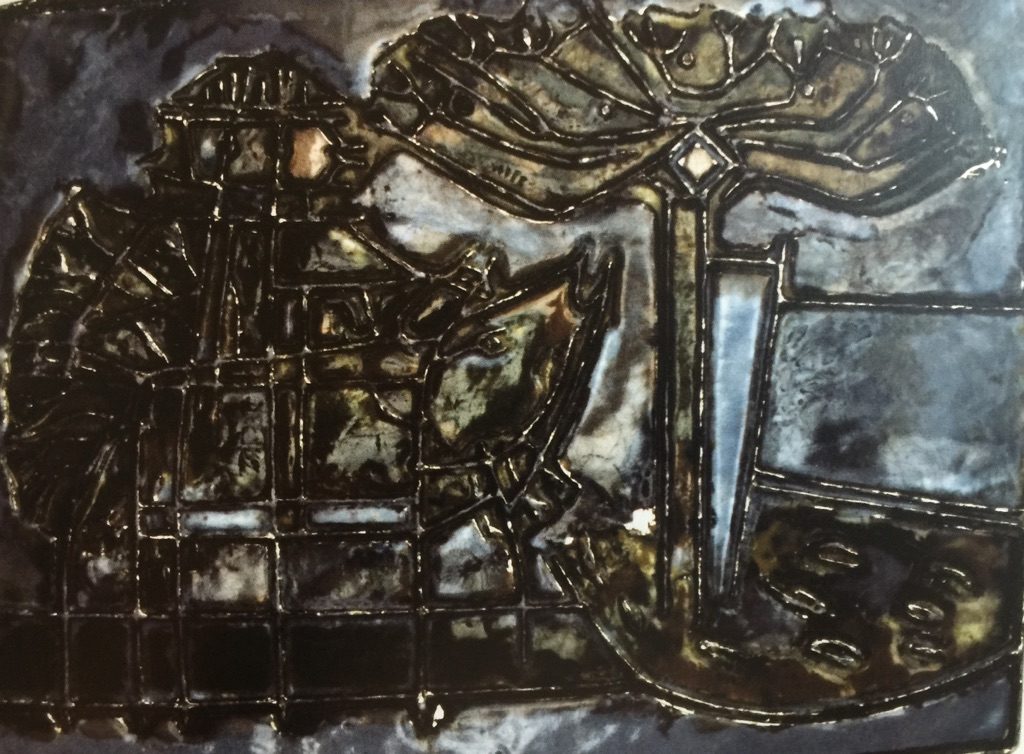
Pilgrimage. Enamel on copper. 1956 (24 in x 32 in). Example of early Knapp work. (Picture credit to Cathy Knapp’s “Stefan Knapp: A Visionary Artist Who Worked in Enamel”.)
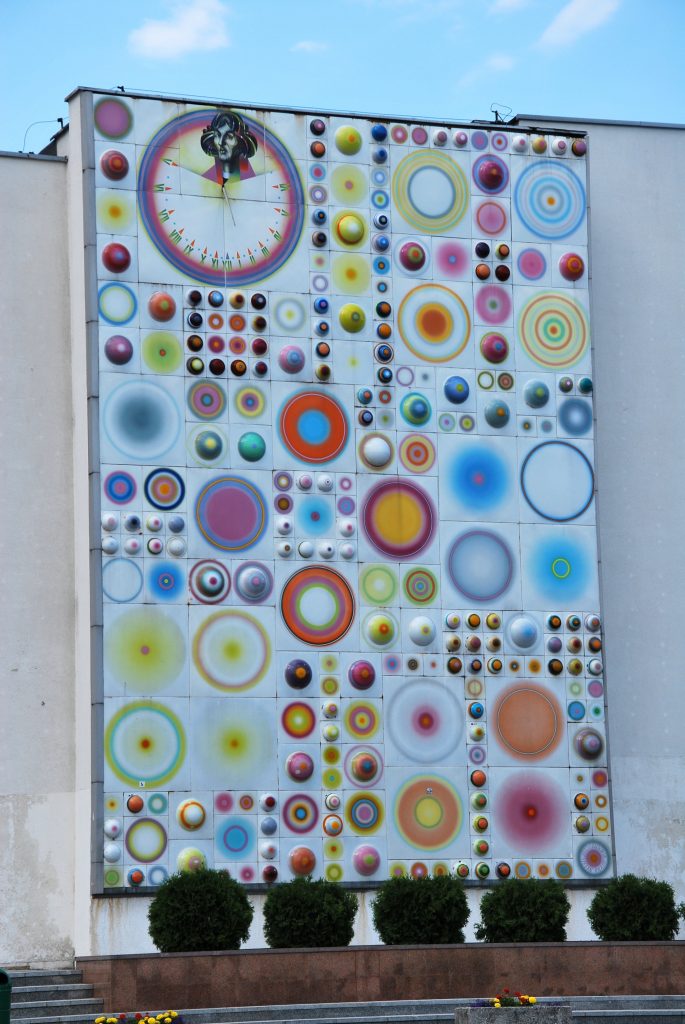
Large mosaic on display at Nicolaus Copernicus University in Toruń, Poland. Enamel on steel. 1972. 1,600 square ft.

Needle of Knowledge Obelisk on display at University of Warwick. 1993. Enamel on steel and stainless steel. 11 ft x 4 ft x 4 ft.
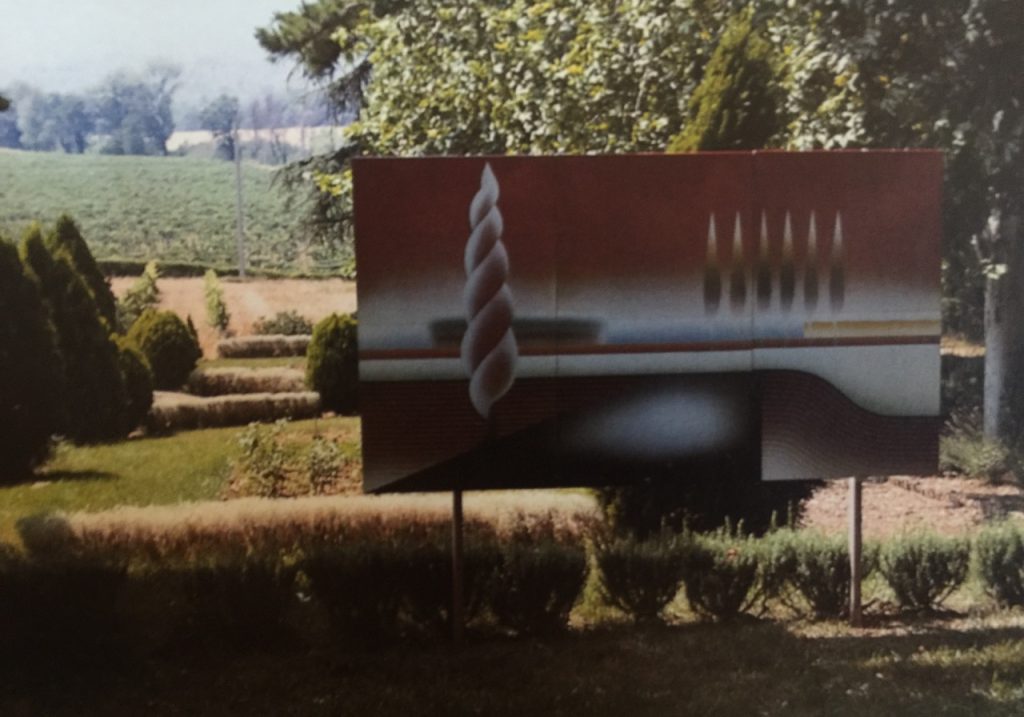
Lavandou Landscape. 3 piece enamel on steel mural. 1980. 6ft x 8 ft. ( Picture credit to Cathy Knapp’s “Stefan Knapp: A Visionary Artist Who Worked in Enamel”.)
In 1960, Knapp was commissioned by George Farkas to do an abstract enamel covering the entire wall of an Alexander’s Department Store building in Paramus, New Jersey. The commission also included smaller enamels for multiple Alexander’s locations. The enamel (below) was 200 feet long by 50 feet high and weighed 250 tons. Knapp laid the enamels on the floor of a very large building and applied liquid enamel with mop-like brushes. He walked on the enamel panels wearing specially designed skis. The panels were made of steel and the abstract designs reflecting images that had remained in Knapp’s memory from his days as a fighter pilot. Some of the people viewing the enamel were on a nearby elevated expressway and their impression of his image would be similar to what he first saw in his plane as they drove by.

Alexander’s Mural. 1961. Enamel on steel. 50 ft x 200 ft. Originally on display at Alexander’s Department Store in Paramus, New Jersey.
The Alexander’s building has been torn down. However the enamel was rescued, and it is now owned by the Bergen Museum of Art and Science in Paterson, New Jersey.
For the month of May, 2016
Pat Johnson lives and works in London, UK. She works on copper and steel panels. She has done some very large enamels on steel panels for outdoor display. Her displays have been installed in parks and on two cruise ships. Her colorful enamels stand out in the North Atlantic climate of cloudy skies and drizzly days.
We are emphasizing her work on steel panels since this is her prominent contribution to the use of enamel in Fine Arts. Her panels are quite large and a series of adjacent panels makes quite a display of the medium. She works on these steel panels with a spray gun to apply industrial liquid enamel as well as jewelry enamel which is sifted on. She fires her enamels at an industrial plant, Burnham Signs, which has made it’s kiln facilities available to her.
For the month of April, 2016
Howard Eisman has said that his art is designed to convey the message that life can be a colorful adventure. Thus, he tries to emphasize color and the illusion of movement in both his figurative and abstract art.
“Double play” is a baseball term for an event that consists of swift movement and acrobatic skill performed before a shouting crowd of enthusiastic spectators. In his enamel on copper piece, “Double Play”, (25″ x 37″). Eisman tries to capture his moment of excitement. This enamel is in the W.W Carpenter Enamel Foundation Art Museum in Bellevue, Kentucky.
The companion pieces, “Orpheus” and “Eurydice” are both 36″ x 22″, enamel on copper three dimension sculptures. They are meant to be displayed on a pedestal. The figures, which protrude from their background, are portrayed as heroic and mythical. The background colors are meant to further define the nature of their personalities.
“Stride” (36” x 25” ) is a free standing sculpture installed in a garden. It is an abstraction which conveys the sense of incisive and spirited, self assured movement. It is made with enamel on cut, shaped, and hammered copper. The base of the enamel is painted wood.
“The Klezmaniacs” (16.5” X 12”) enamel on copper and silver, conveys that rampant energy and wild music of a Klezmer band. Their lively, festive music is represented by the texture of the background, the colors and silver wire symbols on the copper to their left.
Howard Eisman fondly remembers Bill Helwig, who was such a great help to him.
For the month of March, 2016
Delia Dante is an internationally recognized metal and enamel artist who works in Boise, Idaho, where she has a studio and a gallery.
One of her pieces, Me Deuce, below, is in a Boise restaurant. While beautiful, it also may create a somewhat intimidating air. The theme is the mythological Medusa.
 Dante sometimes likes to play with themes that express the mythology of her geographic location, growing up in San Francisco and settling in Boise, Idaho.
Dante sometimes likes to play with themes that express the mythology of her geographic location, growing up in San Francisco and settling in Boise, Idaho.
Of particular interest in enameling, Dante creates art for the outdoors as well as for the interior. Here are three enameled variations on an abstract theme mounted on a rustic stone wall.
 Here is Unity Fountain, a sculptural waterfall which provides a center to a lovely garden. This fountain symbolizes eternal love with two trees intertwined in union, ascending from the earth in springtime through the sky into the heavens.
Here is Unity Fountain, a sculptural waterfall which provides a center to a lovely garden. This fountain symbolizes eternal love with two trees intertwined in union, ascending from the earth in springtime through the sky into the heavens.
For the month of February, 2016
Paul Hultberg, our featured artist, created enamels which are examples of how enamel can be used to make outdoor, large murals. His work also is also a demonstration of the manner in which enamel can be used in abstract expressionist art.
Hultberg was born 1926 in Oakland. He took some classes at Fresno State College and the University of Southern California in Los Angeles. He later developed a strong interest in mural painting. He eventually started his own mural painting business in the 1940’s. He continually experimented with various media to incorporate in his large mural works. In the early 1950’s he taught painting and drawing at the Brooklyn Museum Art School. There he met Walter Rogalski, a printmaker. For a year together they experimented, on combining painting and printmaking techniques with enamels. At first, it was small scale, but Hultberg later developed them into his murals. His enamels have been featured in museums such as the Museum of Contemporary Crafts in New York. He’s received numerous architectural commissions, including one for the Pan Am Building in New York.
Hultberg did not use a kiln for his large mural works. Woodrow Carpenter described the process he used: “Starting with thin copper sheets, a design was drawn with a brush and thin adhesive, enamel powder sifted on, and then all un-adhered enamel was brushed off leaving bare areas. The panel was fired in a furnace of his design.” Each panel was laid on heat- resistant bars, below which was a cart equipped with gas torches. The cart was moved from one end of the panel to the other to fuse glass onto the metal. The enamel was fused to the copper while the bare areas oxidized. Upon cooling the panel was rolled flat. The oxidation popped off leaving a glass design on a background of various colors of copper oxide.”
Please note : AFFAE DOES NOT RECOMMEND FIRING ANY ENAMELS IN THE MANNER PRESENTED ABOVE. It is very dangerous : it could start a fire or an explosion. In addition, such a firing method reduces control of the enamel image, and it may limit the durability and stability of the fired enamel.
Below are some enamel art works done by Hultberg. Please click on the images to enlarge, and for details on the pieces.
For the month of January, 2016
To begin 2016 on a note of innovation, our recognition in January will not be for a single individual enamel artist, but for the Enamel Guild NorthEast (EGNE) and particularly their Exhibition Committee. At the end of 2015, EGNE mounted an exhibition ONLINE only. For the show, called “Under Fire,” pieces were selected for inclusion based strictly on online images, rather risky because it is so difficult to capture enamel surfaces. The intrepid curator, Barbara Seidenath is a metalsmith/enamelist who teaches at Rhode Island School of Design. Her selections are inclusive: “The works range from traditional designs and techniques to thoughtful explorations of form, as well as the experimental use of enamel, all reflecting the diverse ways this medium can be interpreted and applied.” Submissions to “Under Fire” came from 20 U. S. states and 4 other countries. Most of the works are categorized as jewelry and vessels, with 15 pieces of wall art or sculpture. The 15 works are shown below with the artists’ names arranged alphabetically. Kudos to Enamel Guild North East for this innovation.
For more information please check out The Enamel Guild North East – https://www.enamelguildnortheast.org/under-fire/#gallery
Opening of the Enamelist Society Exhibition at the Gallery of the League of New Hampshire Craftsmen, 1/15/2016.
Kudos to the League of New Hampshire Craftsmen! On Friday evening, My wife was blown away by the overall impression of creativity and color at their opening of the Enamelist Society exhibition at the League’s gallery in Concord, N.H.
The venue is considerably more attractive than typical bare rectangular spaces within which enamel art and craft often is displayed. The League has occupied their current location for about three and a half years, and the gallery space has been designed specifically to accommodate art and craft exhibits, with matte black 10-foot ceiling, many great high windows, and movable walls that provide for interesting reconfigurations of the interior space. Catherine Green and her Gallery Committee set up the exhibit to show each piece to advantage and create a breathtaking display. In deference to the artists, no photographing was done in the main gallery, but attached are images of the gracious refreshment table and the display in the adjacent Grodin Museum of selected pieces from the League’s permanent collection. A steady stream of visitors enjoyed the exhibit, welcomed by knowledgeable volunteers who offered information and conversation about the exhibition and the gallery.
The gallery space is helmed by an amazing sculptural reception desk shown below. This project, called “Handcrafting our Headquarters,” was completed lovingly by six New Hampshire craftsmen who consider the work a collaboration in its highest form. Of particular interest to enamelists, nested inside carved wooden frames around the base of the desk are panels of copper. The panels were crafted by Steven Hayden, who applied several thick layers of specially formulated enamels, creating lines and producing a raised texture. He then used torch firing, with careful adjustment of the oxygen in the flame, to create a subtle array of colors from the finely ground copper oxide suspended within the enamel.
There are many considerations that go into the selection of a venue to show our enamels. The welcoming, impressive aesthetics of the League of New Hampshire Craftsmen make their gallery a superb choice. The exhibition continues until March 18, 2016, and I heartily recommend a visit.
Howard Eisman







